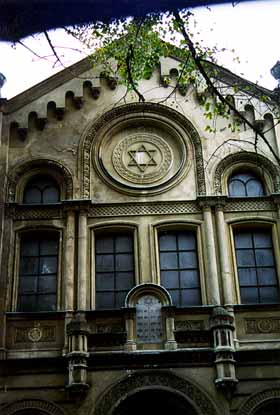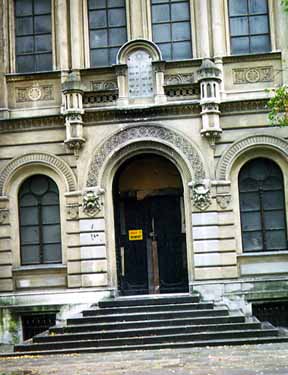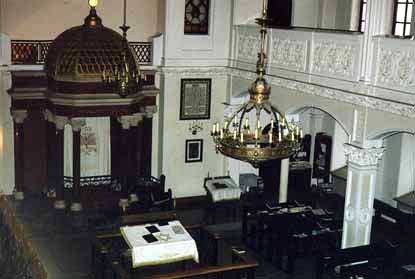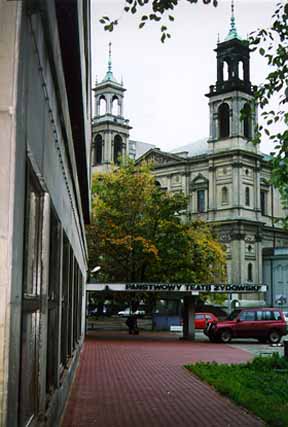Nozyk Synagogue in Warsaw

Upper floors of Nozyk
Synagogue
The Nozyk Synagogue is located at number
6 Twarda Street in an area of Warsaw that was originally inside
the Little Ghetto in 1940, but was later outside the Ghetto after
it was made smaller, following deportations. According to my
tour guide, this Synagogue is the only one in Warsaw that survived
the war; it was used by the Nazis as a stable for their horses
and as a storehouse for food for the horses. The desecration
of Synagogues and Jewish cemeteries was a common way for the
Nazis to show their hatred of the Jews. Out of thousands of Synagogues
in Poland, there are only about 245 remaining. All of the unique
wooden Synagogues were destroyed, although some 17th century
wooden Catholic Churches remain to this day.
The Nozyk Synagogue was named for the
man who founded it in 1900, Zalman ben Menasze Nozyk and his
wife Rywka bat Mosze. (Some guidebooks says it was founded in
1902.) Upkeep on the Synagogue is paid for by funds provided
by Zalman Nozyk in his will.
The photograph above shows the upper
floor of the Synagogue and the one below shows the front door.
Both of these photos were taken in October 1998. A yellow sign
on the door tells visitors that there is no admittance at this
door. The front door had been recently damaged by fire, set by
an arsonist, when I visited it. According to my tour guide, there
have been fires set at other Synagogues in Poland, and even some
fires set at Catholic churches, despite the guards that are posted.
 Entrance to Nozyk Synagogue
after arson fire in September 1998
Entrance to Nozyk Synagogue
after arson fire in September 1998
The Nozyk Synagogue suffered damage in
the Warsaw uprising of August 1944, but was partially restored
and reopened in 1945 when a few survivors returned to Warsaw.
Work on restoration of the building began in 1977 and was completed
in 1983. On April 19, 1983, the 50ieth anniversary of the ghetto
revolt, services were held again for the first time since restoration
began. The anniversary service was attended by both Jews and
Catholics. Since then, services have been held here every Friday
night and every Saturday for about 500 active Jews in Warsaw,
according to my tour guide.
The photo below shows the interior of
the Synagogue, taken from the women's gallery. Part of this gallery
is shown on the right side of the picture. The Holy Ark (Aron
ha Kodesh) on the east wall is shown on the left side of the
picture.
 Interior of Nozyk Synagogue,
taken from women's gallery
Interior of Nozyk Synagogue,
taken from women's gallery
On the western side of Grzybowski Place,
just around the corner from the Nozyk Synagogue, is a theater
built on the site of some former Jewish homes and shops which
were destroyed in World War II. Before the war, Plac Grzybowski
was a busy and colorful market square for Jewish merchants. Inside
the theater, there is an impressive lobby and some photographs
of the Jewish quarter in Warsaw, taken before the war. In the
same building there were the offices of a Jewish newspaper and
a Jewish travel bureau called Our Roots when I visited in 1998.
When we were there, the theater was presenting
the musical "Fiddler on the Roof," the story of life
in a Jewish village in the Pale of Settlement, a strip of land
in what is now the Ukraine and eastern Poland, where the Russian
Jews were forced to live between 1835 and 1917. Between 1881
and the start of World War I in 1914, two million Jews were expelled
from the villages in the Pale by the "May Laws" passed
by the Russians. The story in "Fiddler on the Roof"
ends with this expulsion which started the largest mass migration
of people in history; many of the Jews who left the Pale emigrated
to America. Some chose to settle in Germany or Austria; before
World War I, part of western Poland was included in the Austrian
Empire or Germany. Half a century later, their families again
became victims, this time victims of the Nazis.
The picture below shows the side of the
modern theater building with a marquee sign on the entrance in
front of it. Just across from it is a Catholic Church. The Nozyk
Synagogue and the Church are only about a block apart. This Catholic
Church faced the former Jewish market square, called Plac Grzybowski.
This area was in the Little Ghetto section of the original Warsaw
Ghetto.
 Yiddish Theater to
the left with Catholic Church in background
Yiddish Theater to
the left with Catholic Church in background
|